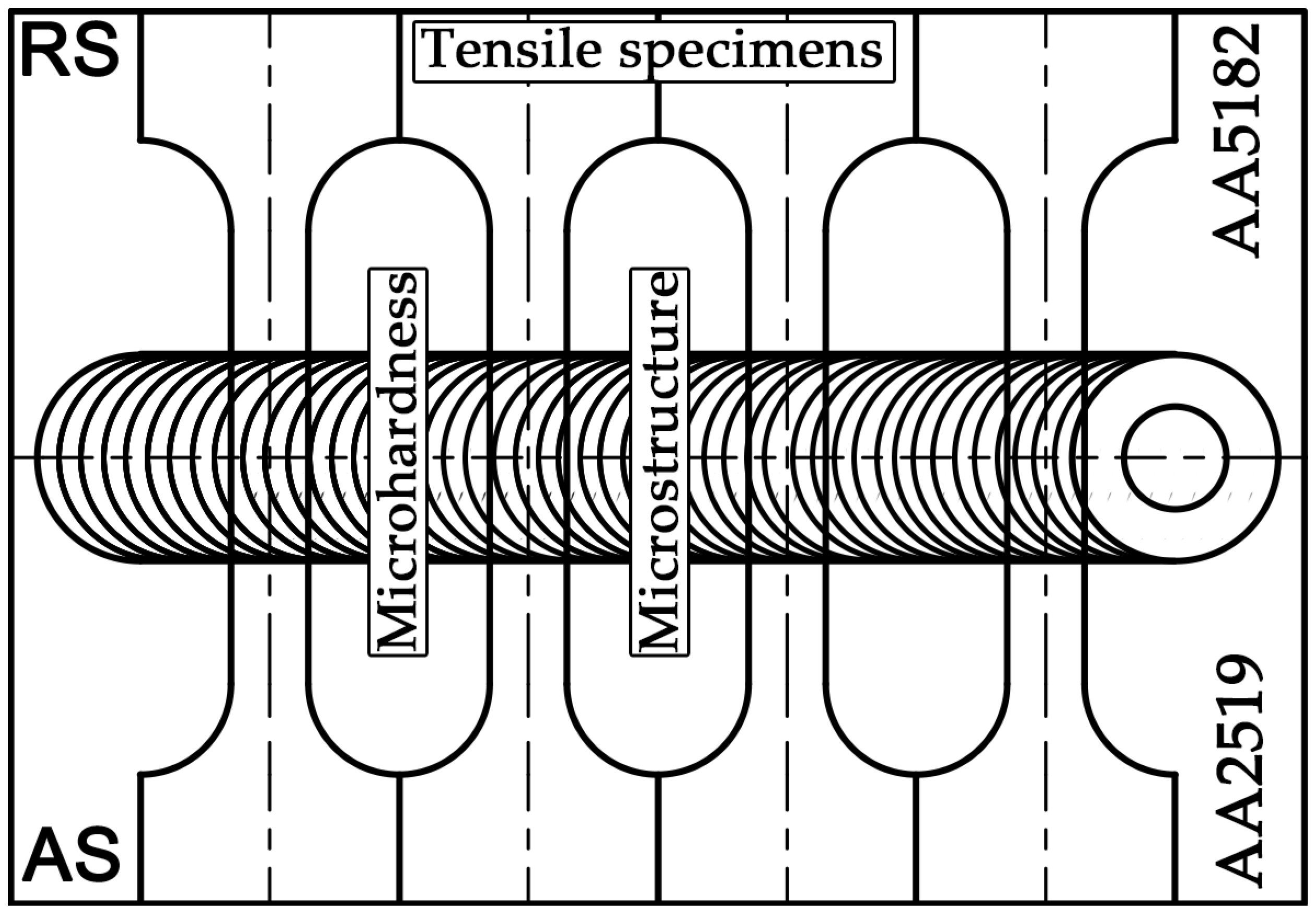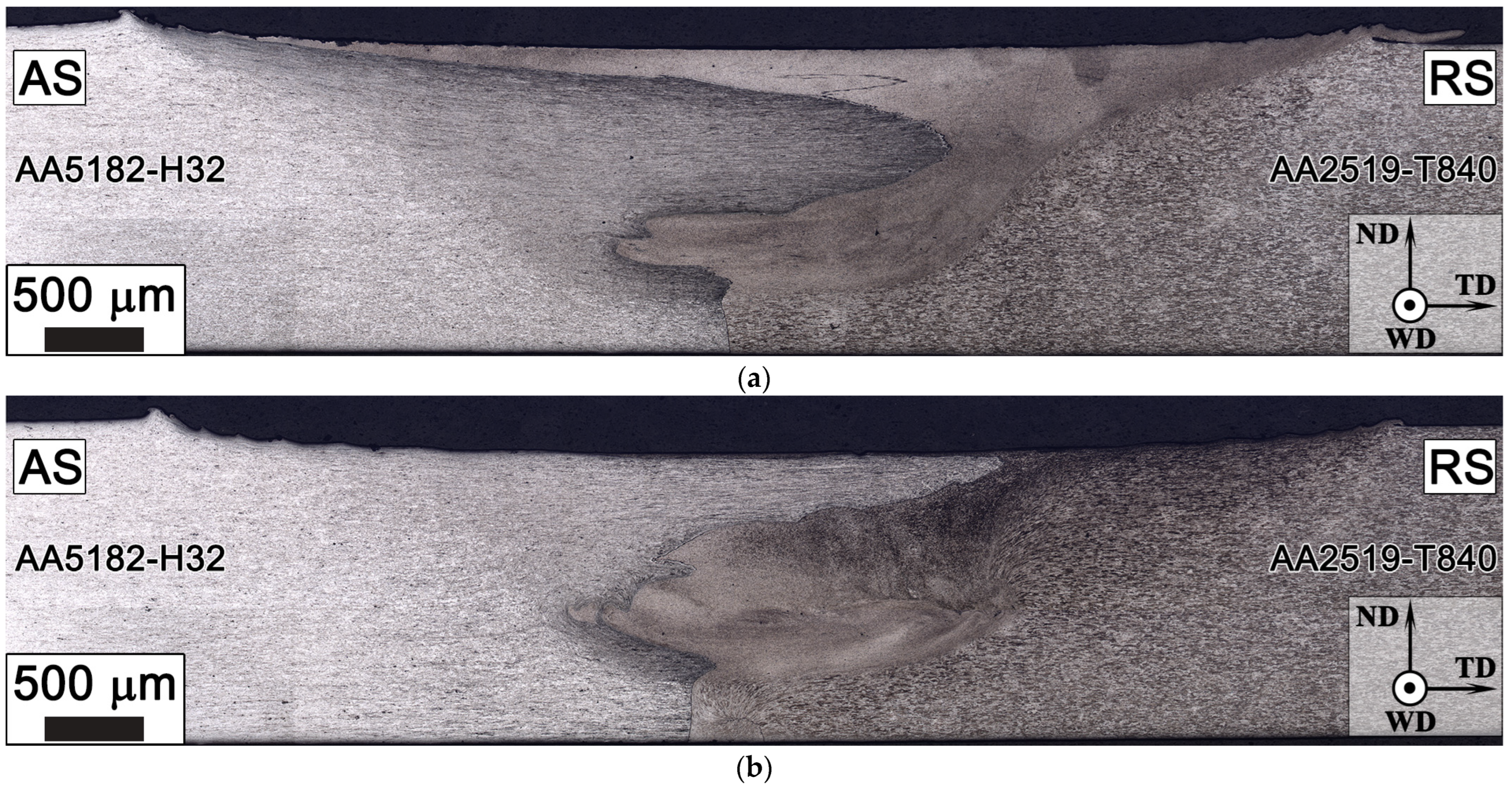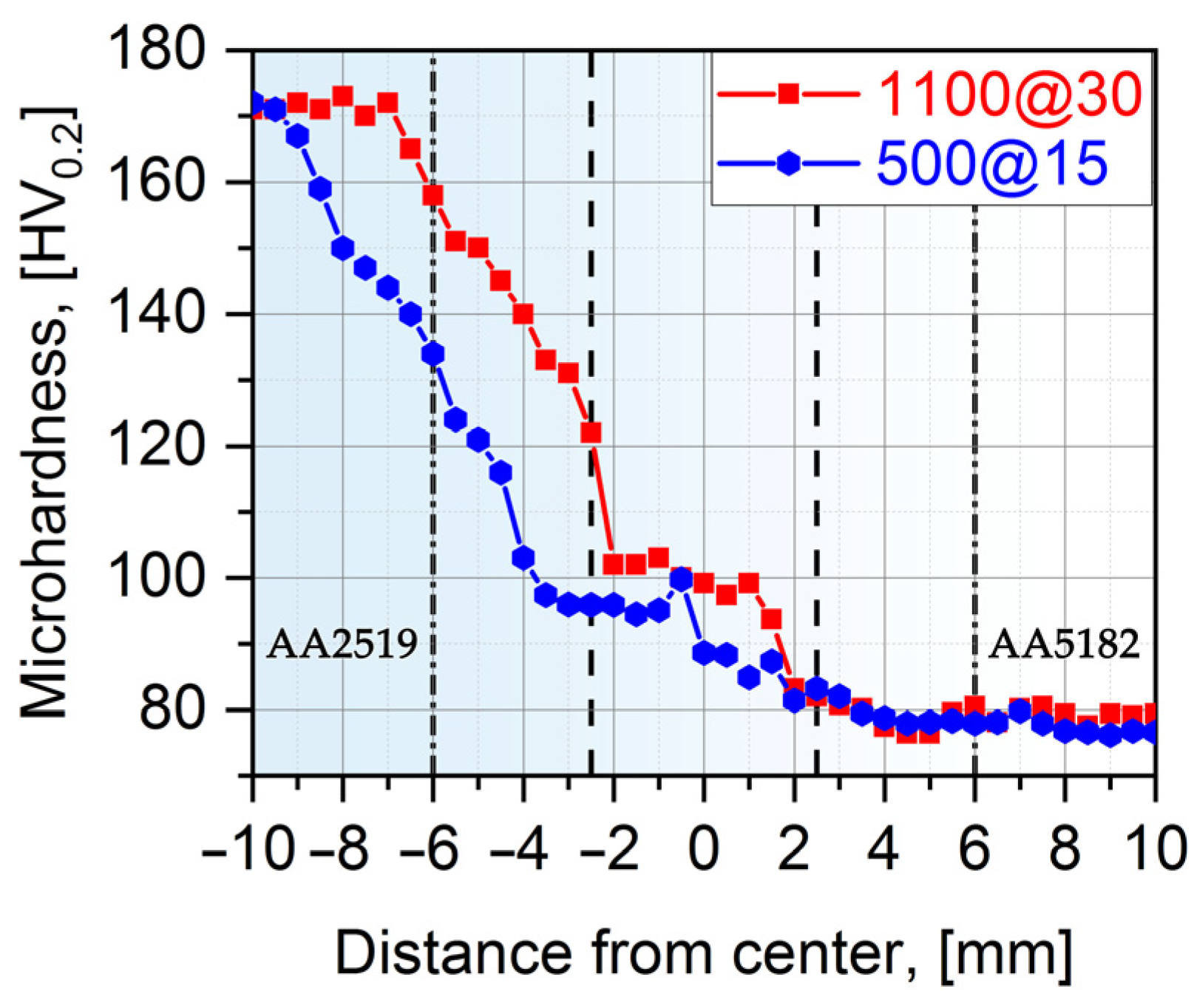Dissimilar Friction Stir Welding of AA2519 and AA5182
Abstract
1. Introduction
2. Materials and Methods
3. Results and Discussion
3.1. Metallography
3.2. Mechanical Testing
3.2.1. Microhardness Survey
3.2.2. Tensile Tests
3.2.3. Material Flow Behaviour Analysis
4. Conclusions
- Under both welding conditions used in this study, defect-free welds were obtained. There is no macroscopic defects or visible porosity across the weld cross section.
- Regardless of FSW regime, the dissimilar joints exhibited ultimate tensile strength (~300 MPa) as high as that of the base material, but ductility is reduced by 2 times. Failures occur in softer AA5182. Therefore, a joint efficiency of ~100% is achieved.
- The variations in microhardness and tensile strength of the dissimilar joints were connected to material flow behaviour, loss of cold work in the HAZ of AA5182, and dissolution and coarsening of precipitates of AA2519.
- The spectacular efficiency due to AA2519 softening does not reach the strength of AA5182.
Supplementary Materials
Author Contributions
Funding
Acknowledgments
Conflicts of Interest
References
- Polmear, I.; Stjohn, D.; Nie, J.F.; Qian, M. Light Alloys: Metallurgy of the Light Metals, 5th ed.; Elsevier Science and Technology Books, Inc.: Oxford, UK, 2017; ISBN 978-0-08-099431-4. [Google Scholar]
- Patel, V.; Li, W.; Wang, G.; Wang, F.; Vairis, A.; Niu, P. Friction Stir Welding of Dissimilar Aluminum Alloy Combinations: State-of-the-Art. Metals 2019, 9, 270. [Google Scholar] [CrossRef]
- Heidarzadeh, A.; Mironov, S.; Kaibyshev, R.; Çam, G.; Simar, A.; Gerlich, A.; Khodabakhshi, F.; Mostafaei, A.; Field, D.P.; Robson, J.D.; et al. Friction stir welding/processing of metals and alloys: A comprehensive review on microstructural evolution. Prog. Mater. Sci. 2020, 117, 100752. [Google Scholar] [CrossRef]
- Olson, D.L.; Siewert, T.A.; Liu, S.; Edwards, G.R. Welding, Brazing, and Soldering; ASM International: Almere, The Netherlands, 1993; Volume 6, ISBN 978-0-87170-382-8. [Google Scholar]
- Mastanaiah, P.; Sharma, A.; Reddy, G.M. Process parameters-weld bead geometry interactions and their influence on mechanical properties: A case of dissimilar aluminium alloy electron beam welds. Def. Technol. 2018, 14, 137–150. [Google Scholar] [CrossRef]
- Shanmuga Sundaram, N.; Murugan, N. Tensile behavior of dissimilar friction stir welded joints of aluminium alloys. Mater. Des. 2010, 31, 4184–4193. [Google Scholar] [CrossRef]
- Mabuwa, S.; Msomi, V. Review on Friction Stir Processed TIG and Friction Stir Welded Dissimilar Alloy Joints. Metals 2020, 10, 142. [Google Scholar] [CrossRef]
- Sayer, S.; Yeni, C.; Ertugrul, O. Comparison of mechanical and microstructural behaviors of tungsten inert gas welded and friction stir welded dissimilar aluminum alloys AA 2014 and AA 5083. Kovove Mater. 2011, 49, 155–162. [Google Scholar] [CrossRef]
- Mishra, R.S.; Ma, Z.Y. Friction stir welding and processing. Mater. Sci. Eng. R. Rep. 2005, 50, 1–78. [Google Scholar] [CrossRef]
- Sejani, D.; Li, W.; Patel, V. Stationary shoulder friction stir welding—Low heat input joining technique: A review in comparison with conventional FSW and bobbin tool FSW. Crit. Rev. Solid State Mater. Sci. 2021, 1–50. [Google Scholar] [CrossRef]
- Meng, X.; Huang, Y.; Cao, J.; Shen, J.; dos Santos, J.F. Recent progress on control strategies for inherent issues in friction stir welding. Prog. Mater. Sci. 2021, 115, 100706. [Google Scholar] [CrossRef]
- ShivaKumar, G.N.; Rajamurugan, G. Friction stir welding of dissimilar alloy combinations—A Review. Proc. Inst. Mech. Eng., Part C J. Mech. Eng. Sci. 2022, 12, 6688–6705. [Google Scholar] [CrossRef]
- Dilip, J.J.S.; Koilraj, M.; Sundareswaran, V.; Ram, G.D.J.; Rao, S.R.K. Microstructural characterization of dissimilar friction stir welds between AA2219 and AA5083. Trans. Indian Inst. Met. 2010, 63, 757–764. [Google Scholar] [CrossRef]
- Koilraj, M.; Sundareswaran, V.; Vijayan, S.; Rao, S.K. Friction stir welding of dissimilar aluminum alloys AA2219 to AA5083—Optimization of process parameters using Taguchi technique. Mater. Des. 2012, 42, 1–7. [Google Scholar] [CrossRef]
- Niu, P.; Li, W.; Chen, D. Strain hardening behavior and mechanisms of friction stir welded dissimilar joints of aluminum alloys. Mater. Lett. 2018, 231, 68–71. [Google Scholar] [CrossRef]
- Niu, P.; Li, W.; Vairis, A.; Chen, D. Cyclic deformation behavior of friction-stir-welded dissimilar AA5083-to-AA2024 joints: Effect of microstructure and loading history. Mater. Sci. Eng. A 2019, 744, 145–153. [Google Scholar] [CrossRef]
- Niu, P.L.; Li, W.Y.; Chen, Y.H.; Liu, Q.P.; Chen, D.L. Base material location dependence of corrosion response in friction-stir-welded dissimilar 2024-to-5083 aluminum alloy joints. Trans. Nonferrous Met. Soc. Chin. 2022, 32, 2164–2176. [Google Scholar] [CrossRef]
- Mastanaiah, P.; Sharma, A.; Reddy, G.M. Dissimilar friction stir welds in AA 2219–AA 5083 aluminium alloys: Effect of process parameters on material inter-mixing, defect formation, and mechanical properties. Trans. Indian Inst. Met. 2016, 69, 1397–1415. [Google Scholar] [CrossRef]
- El-Hafez, H.A.; El-Megharbel, A. Friction stir welding: Dissimilar aluminum alloys. World J. Eng. Technol. 2018, 6, 408–419. [Google Scholar] [CrossRef]
- Manuel, N.; Galvão, I.; Leal, R.M.; Costa, J.D.; Loureiro, A. Nugget Formation and Mechanical Behaviour of Friction Stir Welds of Three Dissimilar Aluminum Alloys. Materials 2020, 13, 2664. [Google Scholar] [CrossRef] [PubMed]
- Manuel, N.; Beltrão, D.; Galvão, I.; Leal, R.M.; Costa, J.D.; Loureiro, A. Influence of Tool Geometry and Process Parameters on Torque, Temperature, and Quality of Friction Stir Welds in Dissimilar Al Alloys. Materials 2021, 14, 6020. [Google Scholar] [CrossRef]
- Crouch, I.G. The Science of Armour Materials; Elsevier: Duxford, UK, 2017; ISBN 978-0-08-101002-0. [Google Scholar]
- Fisher, J.J., Jr.; Kramer, L.S.; Pickens, J.R. Aluminum alloy 2519 in military vehicles. Adv. Mater. Process. 2002, 160, 43–46. [Google Scholar]
- Zuiko, I.S.; Malopheyev, S.; Mironov, S.; Betsofen, S.; Kaibyshev, R. On the Heterogeneous Distribution of Secondary Precipitates in Friction-Stir-Welded 2519 Aluminium Alloy. Metals 2022, 12, 671. [Google Scholar] [CrossRef]
- Zuiko, I.S.; Mironov, S.; Betsofen, S.; Kaibyshev, R. Suppression of abnormal grain growth in friction-stir welded Al–Cu–Mg alloy by lowering of welding temperature. Scr. Mater. 2021, 196, 113765. [Google Scholar] [CrossRef]
- Zuiko, I.S.; Malopheyev, S.; Mironov, S.; Kaibyshev, R. Nanoscale structural evolution of Al2Cu precipitates in friction-stir welded Al-Cu-Mg alloy. IOP Conf. Ser. Mater. Sci. Eng. 2020, 1014, 012063. [Google Scholar] [CrossRef]
- Zuiko, I.S.; Mironov, S.; Kaibyshev, R. Unusual ageing behaviour of friction-stir welded Al-Cu-Mg alloy. Mater. Sci. Eng. A 2020, 793, 139882. [Google Scholar] [CrossRef]
- Zuiko, I.S.; Kaibyshev, R. Deformation structures and strengthening mechanisms in an Al–Cu alloy subjected to extensive cold rolling. Mater. Sci. Eng. A 2017, 702, 108–119. [Google Scholar] [CrossRef]
- Zuiko, I.S.; Kaibyshev, R. Ageing response of cold-rolled Al–Cu–Mg alloy. Mater. Sci. Eng. A 2020, 781, 139148. [Google Scholar] [CrossRef]
- Bharathi, M.S.; Lebyodkin, M.; Ananthakrishna, G.; Fressengeas, C.; Kubin, L.P. The hidden order behind jerky flow. Acta. Mater. 2002, 50, 2813–2824. [Google Scholar] [CrossRef]
- Mogucheva, A.; Yuzbekova, D.; Kaibyshev, R.; Lebedkina, T.; Lebyodkin, M. Effect of Grain Refinement on Jerky Flow in an Al–Mg–Sc Alloy. Metall. Mater. Trans. A 2016, 47, 2093–2106. [Google Scholar] [CrossRef]
- Mastanaiah, P.; Reddy, G.M.; Bhattacharya, A.; Kapil, A.; Sharma, A. Unveiling Liquation and Segregation Induced Failure Mechanism in Thick Dissimilar Aluminum Alloy Electron-Beam Welds. Metals 2022, 12, 486. [Google Scholar] [CrossRef]
- Shah, P.H.; Badheka, V.J. Friction stir welding of aluminium alloys: An overview of experimental findings—Process, variables, development and applications. Proc. Inst. Mech. Eng. Part L J. Mater. Des. Applic. 2017, 6, 1464420716689588. [Google Scholar] [CrossRef]







| Alloy | Composition | Primary Processing | Secondary Processing | |
|---|---|---|---|---|
| Homogenization | Hot Deformation | |||
| AA2519 T840 | Al–5.64Cu–0.33Mn–0.23Mg–0.15Zr–0.11Ti | 10 h at 380 °C followed by 14 h at 510 °C | rolling at ~425 °C to a strain of 1.4 (75% reduction) | 40% cold rolling followed by ageing for 190 °C for a half hour. |
| AA5182 H32 | Al–4.75Mg–0.3Mn–0.15Zr–0.1Ti–0.1Cr | 24 h at 360 °C | forging at ~500 °C | 75% cold rolling followed by annealing for 300 °C for 1 h |
| Weld Designation | Spindle Rate, RPM | Feed Rate, mm/min |
|---|---|---|
| 500@15 | 500 | 380 |
| 1100@30 | 1100 | 760 |
| Alloy/Joint | σYS, MPa | σUTS, MPa | δ, % |
|---|---|---|---|
| BM AA2519 | 438 ± 2 | 488 ± 1 | 8.8 ± 0.9 |
| 500@15 | 162 ± 2 | 309 ± 1 | 13.5 ± 1.4 |
| 1100@30 | 162 ± 2 | 304 ± 1 | 14.7 ± 1.3 |
| BM AA5182 | 164 ± 2 | 313 ± 1 | 26.8 ± 0.5 |
Publisher’s Note: MDPI stays neutral with regard to jurisdictional claims in published maps and institutional affiliations. |
© 2022 by the authors. Licensee MDPI, Basel, Switzerland. This article is an open access article distributed under the terms and conditions of the Creative Commons Attribution (CC BY) license (https://creativecommons.org/licenses/by/4.0/).
Share and Cite
Zuiko, I.S.; Malopheyev, S.; Mironov, S.; Kaibyshev, R. Dissimilar Friction Stir Welding of AA2519 and AA5182. Materials 2022, 15, 8776. https://doi.org/10.3390/ma15248776
Zuiko IS, Malopheyev S, Mironov S, Kaibyshev R. Dissimilar Friction Stir Welding of AA2519 and AA5182. Materials. 2022; 15(24):8776. https://doi.org/10.3390/ma15248776
Chicago/Turabian StyleZuiko, Ivan S., Sergey Malopheyev, Sergey Mironov, and Rustam Kaibyshev. 2022. "Dissimilar Friction Stir Welding of AA2519 and AA5182" Materials 15, no. 24: 8776. https://doi.org/10.3390/ma15248776
APA StyleZuiko, I. S., Malopheyev, S., Mironov, S., & Kaibyshev, R. (2022). Dissimilar Friction Stir Welding of AA2519 and AA5182. Materials, 15(24), 8776. https://doi.org/10.3390/ma15248776







